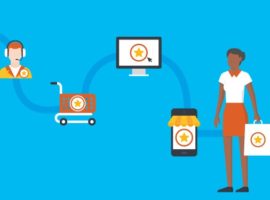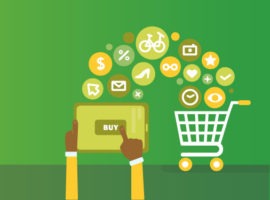How omnichannel and personalization make retail profitable
 Omnichannel strategy encompasses the type of channel used for selling and customer needs, making omnichannel and personalization a must-have for retailers.
Omnichannel strategy encompasses the type of channel used for selling and customer needs, making omnichannel and personalization a must-have for retailers.
E-commerce personalization is nothing new, although it’s evolved greatly from merely being about personalized product recommendations.
For years, it’s been common practice for retailers to use technology and tools to determine the affinity that a customer has towards a particular category, product, or subject in an effort to put the right products and content in front of those customers, based on that affinity. So far, it’s been met with varying degrees of success.
Normally, when we talk about this e-commerce personalization, most people think about product recommendations and content, but rarely do we see someone go much further than that.
E-commerce personalization refers to the process of how brands offer customized experiences for visitors on websites.
Instead of one single experience, holistic e-commerce personalization helps brands provide visitors and customers with unique experiences to meet their desires and preferences.
 Omnichannel strategy encompasses the type of channel used for selling and customer needs, making omnichannel and personalization a must-have for retailers.
Omnichannel strategy encompasses the type of channel used for selling and customer needs, making omnichannel and personalization a must-have for retailers.
Personalization done right means: Customers will be more likely to buy from your brand – and become repeat customers. Consumers are also willing to pay more for personalized experiences.
Personalized product recommendations are usually what comes to mind for many people when talking about personalization.
In its most simple form, we see this in product carousels that can be placed in different areas of a website or in an email. The carousel will contain a set of products that an algorithm has determined a customer may have an interest in, based on data about the customer that’s been collected.
This may be as simple as basic gender and geographic information, and what they’ve previously purchased. It may also include data on which products they look at, content they consume, and even what they post about the brand on social media.
 Types of customer data serve distinct purposes. Identity data, descriptive data, attitudinal data, behavioral data defined, with examples.
Types of customer data serve distinct purposes. Identity data, descriptive data, attitudinal data, behavioral data defined, with examples.
FUN FACT: No matter how much data they use and despite how sophisticated their personalization engine is, brands will only see a limited uplift using product carousels alone.
Most carousels contain up to 10 different products, and the likelihood of one of these products being the one the customer wants to buy at that point in time is relatively low – even if curated by an algorithm. It’s certainly worth doing, but if it’s the only personalization that’s done, let’s just say it’s not going to change the world.
A step further in product personalization is where search results – including catalogue browsing – is personalized. This means that product listings and search result pages are personalized, ensuring that the products for which a customer has affinity (as determined by the personalization algorithm) are pushed upwards in the pages, or that a different set of rules are used when determining the order of products shown on these pages.
This technique is less specific than a product carousel, as it’s effectively adding weightings to certain types of products to ensure that they’re pushed further towards the top of pages.
However, a retailer utilizing this technique can expect to see a larger uplift than when introducing product carousels, as the customer will consistently see products that they have a closer affinity to more often.
 Take control of the customer experience with a powerful product content management that allows you to deliver engaging and consistent product information across all channels.
Take control of the customer experience with a powerful product content management that allows you to deliver engaging and consistent product information across all channels.
Content is another area where brands personalize, and a great number of retailers are using rich content to give them an edge over their competitors.
E-commerce isn’t just about a product catalogue, it’s about an experience, and rich content is often an important part of that experience.
For example, it’s very common for a brand to have a large hero banner on their home page; often pointing to a particular category or product range.
Many brands now personalize this by creating multiple copies of a banner and showing the most relevant one to each customer based on the data that’s been collected about that customer.
It makes complete sense to show customers the content that’s most relevant to them rather than just showing the same thing to everyone.
This technique has been proven to increase KPIs like conversion rates and is almost always worth doing but, on its own, is not going to have a dramatic impact.
 Why is B2B content marketing so important to business? It increases sales, brand awareness, brand trust, and customer loyalty.
Why is B2B content marketing so important to business? It increases sales, brand awareness, brand trust, and customer loyalty.
While many brands are focusing on personalizing product recommendations and content, very few are focusing on personalizing the holistic experience.
Interacting with a website is an experience that has many different aspects. As well as products and content, a user is interacting with:
On most e-commerce websites, these aspects tend to be exactly the same for every customer. While the products and content a customer sees may be personalized, all of the other parts of the experience tend to be the same – this is where holistic experience personalization comes in and can deliver big returns.
Let’s think of a very simple scenario where a multi-category retailer sells clothing as well as homeware. While they’ll have customers who purchase from multiple categories, they’ll also have others that will primarily purchase from a single category.
Most brands will decide which category to display first within the main navigation based on many factors – usually focused on which product category generates the most overall revenue – but this is most often the same for everyone who visits the site. However, if the brand knows that I mainly purchase from the clothing category, there’s a strong argument to show that category to me first in the navigation. This, alone, isn’t going to have a dramatic effect on KPIs but, combined with other changes to the experience, it can start to make a big difference.
A more sophisticated example of holistic personalization could be changing the order of the faceted navigation (filter options that sit on the product listing and search result pages) based on a user’s behavior.
Maybe a specific visitor uses the price slider much more often than they filter by color. If so, the retailer should consider pushing the price slider towards the top of the faceted navigation. Many brands will have a large number of facets that a customer can filter on, but will always show the same facets in the same order to every customer. Why not show the facets that each individual uses most at the top?
You could do the same for sort options, or even automatically show a certain number of products in each row on the product listing page based on how each individual has previously interacted with the website.
How about delivery preferences? If a user most often chooses click and collect, show that option first ahead of other delivery methods.
The same goes for payment methods. If they always use PayPal, make that prominent and the first choice. When you start to think about it, there are many distinct parts of the e-commerce personalization experience that could be altered to perfectly match an individual.
This level of experience personalization is a step beyond content personalization and personalized product recommendations. It’s adapting the holistic experience of the website, based on the perceived preferences of the user; making all aspects of their journey personalized to provide an experience that’s entirely tailored to the way they want to interact with the brand.
 Abandoned shopping carts cost online retailers $18 billion a year. You can reduce the risk with customer data management and CDP.
Abandoned shopping carts cost online retailers $18 billion a year. You can reduce the risk with customer data management and CDP.
Some of the best tools a brand can use to deliver a holistic, personalized e-commerce experience are ones that started life as A/B testing tools, but have evolved into experience personalization platforms. Tools like Dynamic Yield, Monetate, and Optimizely work by intercepting the HTML before it is loaded by a user’s browser, manipulating it based on certain rules, and then showing the altered experience to the user.
This technology allows these tools to change almost any aspect of the website, from the products, the content, the navigation, and almost any part of the experience. A brand can test multiple different experiences at once and measure which delivers the best results.
When they were first developed, these tools knew very little about the individual users and would randomly select which users were shown which experience based on the percentages the brand would configure.
However, over time, they’ve evolved into personalization platforms where they gather data on each user’s behavior; which products and categories they view, what content they consume, what they search for, what they buy and many other aspects of the user’s behavior. They then user artificial intelligence and machine learning to calculate a user’s affinity to a certain category, product, or any other aspect the brand may want to consider. The system will then dynamically segment customers based on this behavior and affinity, then the brand is then able to define which segment will see which experience.
It’s even possible to combine this with data from other touchpoints such as product returns, social interactions, and even purchases from physical stores.
All of this data can be used to provide a 360-degree view of the customer and can be further used to provide personalized experiences, like ensuring online and email product recommendations take in-store actions into account.
Using this technology will allow a brand to deliver an online experience that is wholly personalized to each customer, putting the right products content and overall experience in front of everyone – and having the maximum positive impact on KPIs.